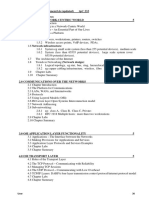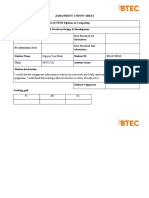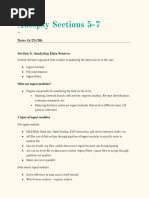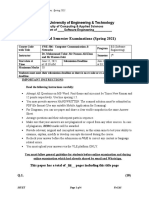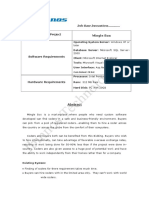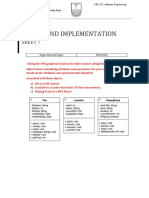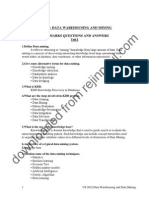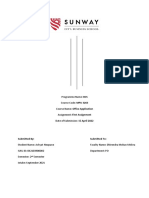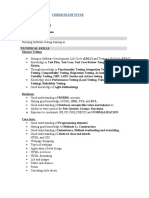0 ratings0% found this document useful (0 votes)
114 viewsCSC 1403 Database Concepts First Assignment
The document discusses a database design for a real estate management system. It identifies six tables - users, property categories, properties, auctions, bids, and chats. It specifies the key fields for each table, identifies the relationships between tables through foreign keys, and fully describes the database design.
Uploaded by
Achyut NeupaneCopyright
© © All Rights Reserved
Available Formats
Download as PDF, TXT or read online on Scribd
0 ratings0% found this document useful (0 votes)
114 viewsCSC 1403 Database Concepts First Assignment
The document discusses a database design for a real estate management system. It identifies six tables - users, property categories, properties, auctions, bids, and chats. It specifies the key fields for each table, identifies the relationships between tables through foreign keys, and fully describes the database design.
Uploaded by
Achyut NeupaneCopyright
© © All Rights Reserved
Available Formats
Download as PDF, TXT or read online on Scribd
You are on page 1/ 6
Programme Name: BCS
Course Code: CSC 1403
Course Name: Database Concepts
Assignment: First Assignment
Date of Submission: 29 June 2022
Submitted By: Submitted To:
Student Name: Achyut Neupane Faculty Name: Satyam Paudel
IUKL ID: 042103900002 Department: PO
Semester: 1st Semester
Intake: September 2021
Q Relational model represents how data is stored in relational databases.
a) Discuss relational database in brief.
→ A relational database (RDB) is a grouping of various data sets that are arranged by
tables, records, and columns. Between database tables, it provides a clear
connection. With the use of tables, data can be searched for, organized, and
reported on more easily.
→ An easy-to-understand method of displaying data in tables, the relational model is
the foundation of relational databases. In a relational database, each row in the
table represents a record with a unique ID known as the key. Each record typically
includes a value for each characteristic, which makes it simple to determine the links
between data points. The columns of the table carry the attributes of the data.
→ Relational Database make use of Structured Query Language (SQL), a common user
application that offers a simple programming interface for database access.
b) Discuss properties of relational databases.
→ A relational database is a collection of data items that have links between them that
have been specified in the database. These connections allow the database to
organize the data in a structured format. These objects are organized in the form of
a series of tables, and each table includes columns and rows that make up its
structure. Tables are the locations in a database where data relating to the entities
that are going to be represented may be found.
→ Relational databases are known for having the following properties:
i. The data are presented in the form of a set of relationships.
ii. To ensure that the data in the database is correct and that it complies with the
rules that have been established, entries are maintained in an atomic manner.
iii. All of the values contained inside a column are assigned to a same data type
regardless of their individual nature.
iv. Each row has its own identity.
v. The sequence in which the columns are presented is arbitrary.
vi. The sequence in which the rows are presented is arbitrary.
vii. Each column may be considered to have its own unique identity.
Q Database design is the organization of data according to a database model. Determining the
purpose of your database helps you prepare for the remaining steps. The process involves:
Finding and organizing the information required, Dividing the information into tables, turning
information items into columns, specifying primary keys, setting up the table relationships,
refining your design, Applying the normalization rules. As a Database designer you are
required to complete following design process and document it properly as a design
document. You can choose the system of your interest and do the following task:
a) Write the proposed database system description in brief.
→ As a database designer, I will be working on the Real Estate Management system.
The system will allow owner/broker to list their property and buyer to bid and buy
the property.
For the proposed system, there will be 6 tables which are: user, property category,
property, auction, bid, and chat.
There will be 4 types of end-users: admin, owner, broker, and general user. The type
of user will be differentiated using ‘role’ property of the user. A property will have
its category related to the category table. When auction is started, user can bid on
the product. At the time end, highest bid will win the auction.
Also, general user can chat with the property listing user. Chats table will have
message: with the text in message, status: whether the message is seen by the
receiver, and ‘from’ & ‘to’ which are sender and receiver respectively.
b) Identify at least five relations with required fields.
→ There are six relations which with required
i. Categories
• “category_id” => integer, auto incrementing
• “category_name” => varchar
• “category_description” => varchar
ii. Users
• “user_id” => integer, auto incrementing
• “full_name” => varchar
• “email” => varchar
• “password” => varchar
• “role” => varchar or enumeration
• “address” => varchar
iii. Properties
• “property_id” => integer, auto incrementing
• “property_title” => varchar
• “property_description” => varchar
• “minimum_price” => decimal float
• “user_id” => integer
• “category_id” => integer
iv. Auctions
• “auction_id” => integer, auto incrementing
• “product_id” => integer
• “auction_start_datetime” => datetime
• “auction_end_datetime” => datetime
• “winner_id” => integer
v. Bids
• “bid_id” => integer, auto incrementing
• “auction_id” => integer
• “user_id” => integer
• “amount” => decimal float
• “bid_datetime” => datetime
vi. Chats
• “chat_id” => integer, auto incrementing
• “message” => varchar
• “status” => integer or enumeration or boolean
• “from_user_id” => integer
• “to_user_id” => integer
• “chat_datetime” => datetime
c) Specify all the relationship keys of the relations.
→ The relationship keys for the given relations are:
i. Categories
• “category_id + category_name” is the super key
• “category_id” is the candidate key and the primary key
ii. Users
• “user_id + full_name + email” is the super key
• “user_id” is the candidate key and the primary key
iii. Properties
• “property_id + property_title” is the super key
• “property_id” is the candidate key and the primary key
iv. Auctions
• “auction_id + auction_start_datetime + auction_end_datetime” is the super
key
• “auction_id” is the candidate key and the primary key
v. Bids
• “bid_id + amount + bid_datetime” is the super key
• “bid_id” is the candidate key and the primary key
vi. Chats
• “chat_id + status + from_user_id + to_user_id + chat_datetime” is the super
key
• “chat_id” is the candidate key and the primary key
d) Set up the table relationship by specifying foreign keys wherever applicable.
→ The table relationship has following foreign keys:
i. Categories
• Doesn’t have any foreign key
ii. Users
• Doesn’t have any foreign key
iii. Properties
• “user_id” is referencing to ‘users’ relation
• “category_id” is referencing to ‘categories’ relation
iv. Auctions
• “winner_id” is referencing to ‘users’ relation
• “product_id” is referencing to ‘products’ relation
v. Bids
• “auction_id” is referencing to ‘auctions’ relation
• “user_id” is referencing to ‘users’ relation
vi. Chats
• “from_user_id” is referencing to ‘users’ relation
• “to_user_id” is referencing to ‘users’ relation
You might also like
- Introduction To Big Data With Spark and HadoopNo ratings yetIntroduction To Big Data With Spark and Hadoop61 pages
- KCA University Nairobi, Kenya Bit 2108: Object Oriented ProgrammingNo ratings yetKCA University Nairobi, Kenya Bit 2108: Object Oriented Programming28 pages
- Session2 - Advanced Webinar Data Analysis Tools For High Resolution Air Quality Satellite Datasets PDFNo ratings yetSession2 - Advanced Webinar Data Analysis Tools For High Resolution Air Quality Satellite Datasets PDF43 pages
- SAP EPC Enterprise Project Connection 2018No ratings yetSAP EPC Enterprise Project Connection 201819 pages
- CSC 1017 System Analysis and Design First AssignmentNo ratings yetCSC 1017 System Analysis and Design First Assignment6 pages
- A STUDY OF FIREWORK INDUSTRY ON THE HEALTH PROJECT-compressedNo ratings yetA STUDY OF FIREWORK INDUSTRY ON THE HEALTH PROJECT-compressed66 pages
- Topic 5: Lesson 1: Configuring, Managing, and Troubleshooting Resource AccessNo ratings yetTopic 5: Lesson 1: Configuring, Managing, and Troubleshooting Resource Access53 pages
- CST 499 - Capstone Final Report - Koyama 3No ratings yetCST 499 - Capstone Final Report - Koyama 326 pages
- Pocket Certificates Using Double Encryption: FeaturesNo ratings yetPocket Certificates Using Double Encryption: Features4 pages
- MCSA in Windows Server 2012 R2 Course Outline PDFNo ratings yetMCSA in Windows Server 2012 R2 Course Outline PDF5 pages
- Informatics College Pokhara: Introduction To Information System CC4057NP Coursework 3100% (1)Informatics College Pokhara: Introduction To Information System CC4057NP Coursework 323 pages
- Chapter 7: Printers and Scanners: IT Essentials: PC Hardware and Software v4.1No ratings yetChapter 7: Printers and Scanners: IT Essentials: PC Hardware and Software v4.162 pages
- Ip Security Overview: Applications of IpsecNo ratings yetIp Security Overview: Applications of Ipsec14 pages
- Checkpoint Object Filler and Object Dumper PresentationNo ratings yetCheckpoint Object Filler and Object Dumper Presentation48 pages
- CCNA Dis2 - Chapter 6 - Routing - PPT (Compatibility Mode)No ratings yetCCNA Dis2 - Chapter 6 - Routing - PPT (Compatibility Mode)66 pages
- 1618-asm2-Mai Trần Nguyên Khôi-GBS190474No ratings yet1618-asm2-Mai Trần Nguyên Khôi-GBS19047449 pages
- Database - NCC - June2009 - Assingment - IadcsNo ratings yetDatabase - NCC - June2009 - Assingment - Iadcs31 pages
- SPiiPlus C and C++ Library For Linux Based Systems Installation GuideNo ratings yetSPiiPlus C and C++ Library For Linux Based Systems Installation Guide27 pages
- Motherboard Definition Types Components Ports - Network HelpNo ratings yetMotherboard Definition Types Components Ports - Network Help17 pages
- A Comprehensive Survey On Authentication and Secure Key Management in Internet of ThingsNo ratings yetA Comprehensive Survey On Authentication and Secure Key Management in Internet of Things31 pages
- Guide To Managing and Maintaining Your PC Chapter 40% (1)Guide To Managing and Maintaining Your PC Chapter 426 pages
- Computer Architecture: Dept. of Computer Science (UOG) University of GujratNo ratings yetComputer Architecture: Dept. of Computer Science (UOG) University of Gujrat20 pages
- 1.5.3.5 Packet Tracer - Creating A Cyber World0% (1)1.5.3.5 Packet Tracer - Creating A Cyber World4 pages
- Movie World Portal Mini Project AbstractNo ratings yetMovie World Portal Mini Project Abstract3 pages
- Sat - 78.Pdf - Adaptive Transmission of Sensitive Information in Online Social NetworksNo ratings yetSat - 78.Pdf - Adaptive Transmission of Sensitive Information in Online Social Networks11 pages
- Object Oriented Programming Coursework For Endterm: OtodecksNo ratings yetObject Oriented Programming Coursework For Endterm: Otodecks6 pages
- MKTG 1010 Basic Marketing Second AssignmentNo ratings yetMKTG 1010 Basic Marketing Second Assignment7 pages
- CSC 1612 Data Communication and Networking Group ProjectNo ratings yetCSC 1612 Data Communication and Networking Group Project31 pages
- CSC 1301 Fundamental of Software Engineering Third AssignmentNo ratings yetCSC 1301 Fundamental of Software Engineering Third Assignment5 pages
- LANG 2604 Technical and Professional Communication Third AssignmentNo ratings yetLANG 2604 Technical and Professional Communication Third Assignment3 pages
- CSC 1403 Database Concepts Group ProjectNo ratings yetCSC 1403 Database Concepts Group Project16 pages
- LANG 2604 Technical and Professional Communication Individual ProjectNo ratings yetLANG 2604 Technical and Professional Communication Individual Project2 pages
- MPU 3283 Small Group Communication Third AssignmentNo ratings yetMPU 3283 Small Group Communication Third Assignment4 pages
- MPU 3283 Small Group Communication First AssignmentNo ratings yetMPU 3283 Small Group Communication First Assignment3 pages
- CSC 1301 Fundamental of Software Engineering First AssignmentNo ratings yetCSC 1301 Fundamental of Software Engineering First Assignment4 pages
- MGMT 1210 Organizational Management First AssignmentNo ratings yetMGMT 1210 Organizational Management First Assignment3 pages
- MPU 3263 Office Application First AssignmentNo ratings yetMPU 3263 Office Application First Assignment6 pages
- CSC 1513 Programming Fundamental Individual ProjectNo ratings yetCSC 1513 Programming Fundamental Individual Project12 pages
- MPU 3432 Badminton Intra-College Badminton Tournament ProposalNo ratings yetMPU 3432 Badminton Intra-College Badminton Tournament Proposal7 pages
- MPU 3432 Badminton Intra-College Badminton Tournament Final ReportNo ratings yetMPU 3432 Badminton Intra-College Badminton Tournament Final Report11 pages
- CSC 1002 Computer Architecture Second AssignmentNo ratings yetCSC 1002 Computer Architecture Second Assignment4 pages
- CSC 1002 Computer Architecture Third AssignmentNo ratings yetCSC 1002 Computer Architecture Third Assignment4 pages
- 50+ Best Web Development Tools and Resources PDFNo ratings yet50+ Best Web Development Tools and Resources PDF20 pages
- REST APIs Part 1 - HTTP Is For More Than Web Browsing PDFNo ratings yetREST APIs Part 1 - HTTP Is For More Than Web Browsing PDF30 pages
- Semrush-Site Audit Compare Crawls-Mobiledokkan-19th May 2023No ratings yetSemrush-Site Audit Compare Crawls-Mobiledokkan-19th May 20237 pages
- VU Quiz Firewall Bypass (VUBuddy)_ a.I Quiz Solver & One-Click Lecture SkipNo ratings yetVU Quiz Firewall Bypass (VUBuddy)_ a.I Quiz Solver & One-Click Lecture Skip4 pages
- UNIT2 - Logic Design With Behavioral Models of Combinational and Sequential LogicNo ratings yetUNIT2 - Logic Design With Behavioral Models of Combinational and Sequential Logic48 pages
- Systemverilog A Design & Synthesis Perspective: Karen Pieper R&D Manager, HDL CompilerNo ratings yetSystemverilog A Design & Synthesis Perspective: Karen Pieper R&D Manager, HDL Compiler16 pages
- 30 Top Node - Js Interview Questions and Answers (Most Popular)No ratings yet30 Top Node - Js Interview Questions and Answers (Most Popular)2 pages
- © 1996-2009 Operation Technology, Inc. - Workshop Notes: User-Defined Dynamic ModelsNo ratings yet© 1996-2009 Operation Technology, Inc. - Workshop Notes: User-Defined Dynamic Models25 pages
- Implementation of Round Robin Scheduling by MOHAMMAD GHUFRAN - 19DCS030No ratings yetImplementation of Round Robin Scheduling by MOHAMMAD GHUFRAN - 19DCS0305 pages
- RML Language for Modeling Software RequirementsNo ratings yetRML Language for Modeling Software Requirements2 pages
- KCA University Nairobi, Kenya Bit 2108: Object Oriented ProgrammingKCA University Nairobi, Kenya Bit 2108: Object Oriented Programming
- Session2 - Advanced Webinar Data Analysis Tools For High Resolution Air Quality Satellite Datasets PDFSession2 - Advanced Webinar Data Analysis Tools For High Resolution Air Quality Satellite Datasets PDF
- CSC 1017 System Analysis and Design First AssignmentCSC 1017 System Analysis and Design First Assignment
- A STUDY OF FIREWORK INDUSTRY ON THE HEALTH PROJECT-compressedA STUDY OF FIREWORK INDUSTRY ON THE HEALTH PROJECT-compressed
- Topic 5: Lesson 1: Configuring, Managing, and Troubleshooting Resource AccessTopic 5: Lesson 1: Configuring, Managing, and Troubleshooting Resource Access
- Pocket Certificates Using Double Encryption: FeaturesPocket Certificates Using Double Encryption: Features
- Informatics College Pokhara: Introduction To Information System CC4057NP Coursework 3Informatics College Pokhara: Introduction To Information System CC4057NP Coursework 3
- Chapter 7: Printers and Scanners: IT Essentials: PC Hardware and Software v4.1Chapter 7: Printers and Scanners: IT Essentials: PC Hardware and Software v4.1
- Checkpoint Object Filler and Object Dumper PresentationCheckpoint Object Filler and Object Dumper Presentation
- CCNA Dis2 - Chapter 6 - Routing - PPT (Compatibility Mode)CCNA Dis2 - Chapter 6 - Routing - PPT (Compatibility Mode)
- SPiiPlus C and C++ Library For Linux Based Systems Installation GuideSPiiPlus C and C++ Library For Linux Based Systems Installation Guide
- Motherboard Definition Types Components Ports - Network HelpMotherboard Definition Types Components Ports - Network Help
- A Comprehensive Survey On Authentication and Secure Key Management in Internet of ThingsA Comprehensive Survey On Authentication and Secure Key Management in Internet of Things
- Guide To Managing and Maintaining Your PC Chapter 4Guide To Managing and Maintaining Your PC Chapter 4
- Computer Architecture: Dept. of Computer Science (UOG) University of GujratComputer Architecture: Dept. of Computer Science (UOG) University of Gujrat
- Sat - 78.Pdf - Adaptive Transmission of Sensitive Information in Online Social NetworksSat - 78.Pdf - Adaptive Transmission of Sensitive Information in Online Social Networks
- Object Oriented Programming Coursework For Endterm: OtodecksObject Oriented Programming Coursework For Endterm: Otodecks
- CSC 1612 Data Communication and Networking Group ProjectCSC 1612 Data Communication and Networking Group Project
- CSC 1301 Fundamental of Software Engineering Third AssignmentCSC 1301 Fundamental of Software Engineering Third Assignment
- LANG 2604 Technical and Professional Communication Third AssignmentLANG 2604 Technical and Professional Communication Third Assignment
- LANG 2604 Technical and Professional Communication Individual ProjectLANG 2604 Technical and Professional Communication Individual Project
- MPU 3283 Small Group Communication Third AssignmentMPU 3283 Small Group Communication Third Assignment
- MPU 3283 Small Group Communication First AssignmentMPU 3283 Small Group Communication First Assignment
- CSC 1301 Fundamental of Software Engineering First AssignmentCSC 1301 Fundamental of Software Engineering First Assignment
- MGMT 1210 Organizational Management First AssignmentMGMT 1210 Organizational Management First Assignment
- CSC 1513 Programming Fundamental Individual ProjectCSC 1513 Programming Fundamental Individual Project
- MPU 3432 Badminton Intra-College Badminton Tournament ProposalMPU 3432 Badminton Intra-College Badminton Tournament Proposal
- MPU 3432 Badminton Intra-College Badminton Tournament Final ReportMPU 3432 Badminton Intra-College Badminton Tournament Final Report
- REST APIs Part 1 - HTTP Is For More Than Web Browsing PDFREST APIs Part 1 - HTTP Is For More Than Web Browsing PDF
- Semrush-Site Audit Compare Crawls-Mobiledokkan-19th May 2023Semrush-Site Audit Compare Crawls-Mobiledokkan-19th May 2023
- VU Quiz Firewall Bypass (VUBuddy)_ a.I Quiz Solver & One-Click Lecture SkipVU Quiz Firewall Bypass (VUBuddy)_ a.I Quiz Solver & One-Click Lecture Skip
- UNIT2 - Logic Design With Behavioral Models of Combinational and Sequential LogicUNIT2 - Logic Design With Behavioral Models of Combinational and Sequential Logic
- Systemverilog A Design & Synthesis Perspective: Karen Pieper R&D Manager, HDL CompilerSystemverilog A Design & Synthesis Perspective: Karen Pieper R&D Manager, HDL Compiler
- 30 Top Node - Js Interview Questions and Answers (Most Popular)30 Top Node - Js Interview Questions and Answers (Most Popular)
- © 1996-2009 Operation Technology, Inc. - Workshop Notes: User-Defined Dynamic Models© 1996-2009 Operation Technology, Inc. - Workshop Notes: User-Defined Dynamic Models
- Implementation of Round Robin Scheduling by MOHAMMAD GHUFRAN - 19DCS030Implementation of Round Robin Scheduling by MOHAMMAD GHUFRAN - 19DCS030



















